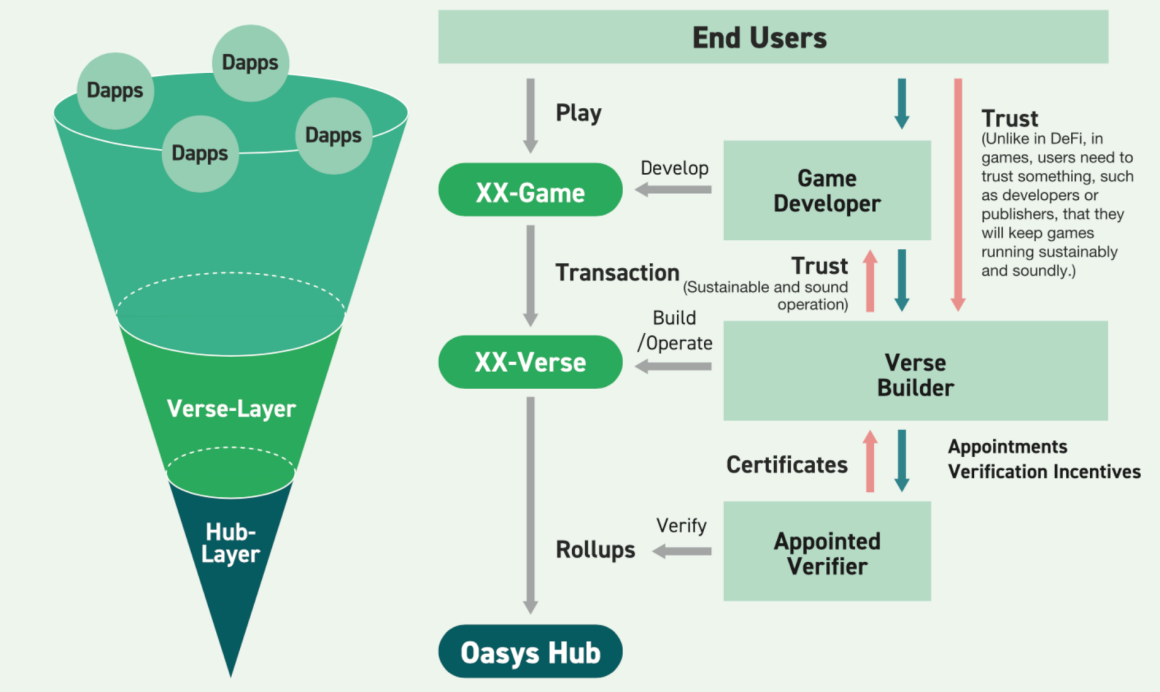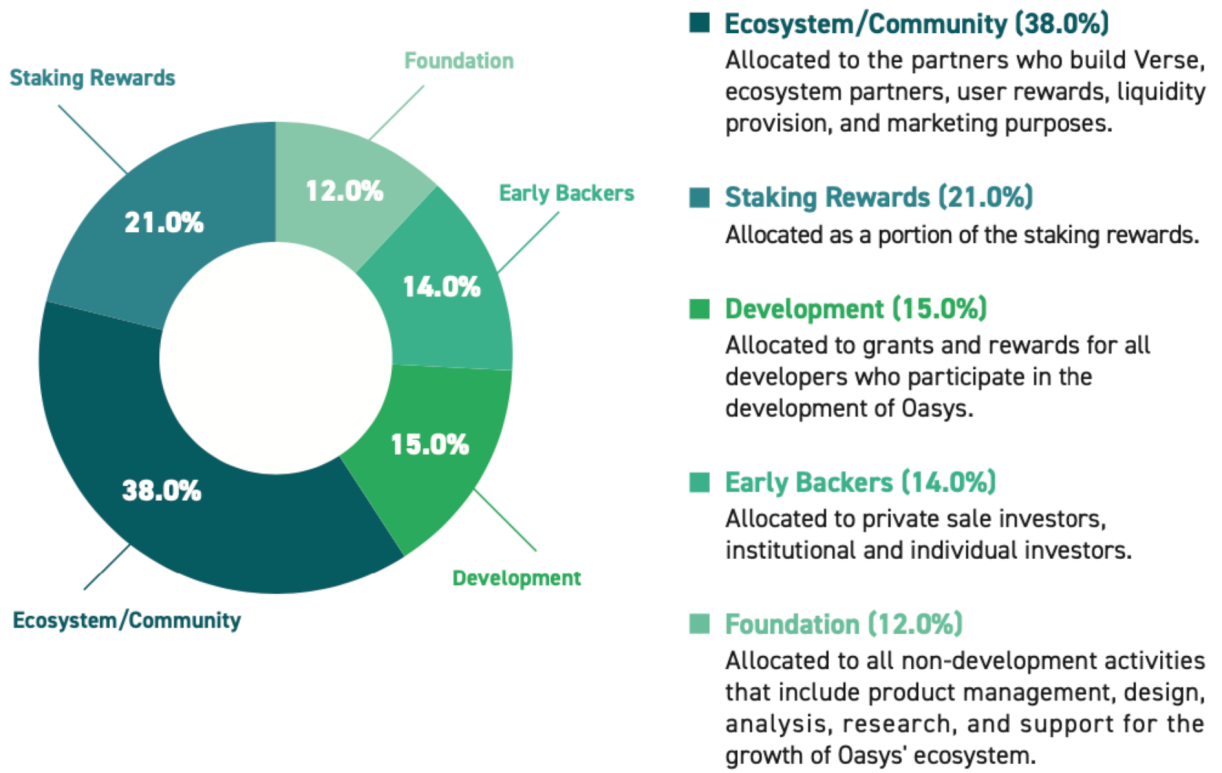A Detailed Explanation of Oasys: A High-Speed Game Public Chain with Zero Fees Compatible with EVM
Author: Li Ke, PANews
The game public chain Oasys, jointly launched by Japan's Bandai Namco and Sega, is a sidechain compatible with Ethereum EVM and supports multi-chain interaction. Oasys adopts a PoS consensus mechanism and consists of Layer 1 and Layer 2, with the first layer primarily used for mainnet consensus and games mainly running on the second layer network. On the Oasys public chain, game developers can run their own Layer 2, and users do not need to pay Gas fees, which are borne by the developers. Oasys aims to enhance the experience and adoption of blockchain games through faster transaction speeds and zero Gas fees.

Oasys Public Chain Ecological Map
In July of this year, Oasys completed a $20 million token private placement round led by Republic Capital, with participation from Jump Crypto, Crypto.com, Huobi, Kucoin, Bitbank, and Mirana Ventures. On December 6, Oasys announced the completion of a new round of strategic financing, with participation from Galaxy Interactive, South Korean gaming giant Nexon, Jets Capital, ChainGuardians, among others, though the amount raised was not disclosed. Additionally, Oasys allocated $1 million to the Republic platform for public offerings at a price of $0.035 USD, which was completed within 12 hours.
Team Members
The founding members of Oasys mainly come from well-known companies in the gaming and blockchain industries.

- Gabby Dizon: Co-founder of the gaming guild YGG (Yield Guild Games).
- Hajime Nakatani: President and CEO of Bandai Namco Research.
- Hironobu Ueno: CEO of blockchain game company double jump.tokyo.
- Hironao Kunimitsu: Founder of Gumi and CEO of Thirdverse.
- Shuji Utsumi: Co-COO of Sega and founding member of PlayStation.
The main development team behind Oasys comes from the Japanese chain game development company double jump.tokyo. Similar to the reason for developing the Ronin public chain for Axie Infinity, double jump.tokyo encountered many pain points during the development of the chain game My Crypto Heroes, leading them to decide to develop an independent game-specific blockchain to address these issues. Therefore, the founder of double jump.tokyo is also one of the co-founders of Oasys. Currently, another Japanese blockchain game company, Crypto Games Inc., has also joined the development of Oasys, having developed the blockchain game Crypto Spells since 2019.

Development Company Behind Oasys
Oasys Layer 1: Oasys Hub
Oasys is a multi-layer EVM-compatible PoS public blockchain, consisting of a first layer called Hub-Layer and a second layer called Verse-Layer. Oasys Hub is the hub layer of Oasys, where game developers can develop their own Layer 2 games. OAS holders can delegate staking OAS in Oasys Hub, validators can manage nodes in Oasys Hub, and gamers can find games of interest through Oasys Hub.

Diagram of Oasys Layer 1 (Oasys-Hub) and Layer 2 (X-Verse) along with external networks
High Network Stability
Like Ethereum, the block time for Oasys Hub is set to 15 seconds. The Hub-Layer has sufficient elasticity to operate with thousands of connected Layer 2 Verse-Layers without the risk of network failure due to node failures.
High Scalability
In principle, the Hub-Layer is only used to run FT, NFT, Bridge, and Rollup contracts, with the main transactions occurring on the Layer 2 Verse Layer. In exceptional cases, some general contracts can be deployed on the Hub-Layer with governance approval, but these contracts are controlled by governance, so the stability of the blockchain is not affected. Additionally, when Verse-Layer transactions are published to the Hub-Layer, Rollup minimizes the number of transactions on the Hub-Layer, so the increase in Verse-Layer transactions does not affect the performance and scalability of the Hub-Layer.
High Data Availability
Transaction data on the Verse-Layer (Layer 2) is reflected on the Hub-Layer (Layer 1), making any events in the Verse-Layer verifiable.
Oasys launched its mainnet on October 25 and began operation with 21 institutional nodes to maintain the network. To build a good gaming and public chain ecosystem, Oasys chose well-known gaming companies and Web3 companies as validator nodes. Currently, the main node operators include Bandai Namco Research, Sega, renowned gaming company Ubisoft, gaming guild YGG (Yield Guild Games), South Korean game developer com2us, and crypto investment firm Jump Crypto. After the mainnet launch, Oasys stated that it plans to recruit more relevant companies to become validators.

Oasys's 21 Institutional Nodes
Oasys Layer 2: Verse Layer
Oasys has named its Layer 2 network Verse Layer, with "Verse" derived from the latter part of "Metaverse," symbolizing that each Layer 2 network is an independent small universe where developers can create independent games or metaverse applications.
Currently, Oasys's Layer 2 network uses Optimistic Rollups technology, but Oasys has eliminated the 7-day challenge period of Optimistic Rollups, making it faster than other blockchains' Layer 2 solutions. The transaction speed on Oasys Layer 2 can reach the same speed level as Web2 products.

Oasys Network Operating Mechanism
Moreover, since all data on Oasys is stored in the Hub-Layer, high data availability can be achieved, allowing for complete recovery even if the Verse-Layer is lost.
Currently, Oasys only supports Optimistic Rollups, but as Ethereum's scaling solutions continue to advance, Oasys will timely support ZK-rollups and other new technologies.
Three Types of Tokens Supported on Oasys
The Oasys network includes fungible tokens (FT) and non-fungible tokens (NFT, Non-Fungible Token). Depending on different network layers, there are three types of tokens in the Oasys ecosystem.

Three Types of Tokens in the Oasys Ecosystem
1. vFT/vNFT, In-Application Tokens for Layer 2
vFT/vNFT can be minted in the Verse-Layer, with "v" representing verse. These tokens can only be used within certain Verse-Layers. Such FTs (like game coins) and NFTs (like IPs) cannot be bridged across chains.
2. oFT/oNFT, Interoperable Tokens for Hub Layer
oFT/oNFT can be minted on the Hub-Layer, with "o" representing hub. These tokens are interoperable and can be used across all Verse-Layers. Additionally, they can be sent to another network, such as Ethereum, via cross-chain bridges.
3. exFT/exNFT, External Network Tokens
exFT/exNFT are tokens minted on networks outside of Oasys, with "ex" representing external. They can be used on Oasys's Hub-Layer and Verse-Layer via cross-chain bridges.
Project Token Economics
The entire token economics of Oasys is based on a multi-token economy rather than solely relying on the OAS token (Oasys's native token). The OAS token serves as the foundational native token of the Oasys ecosystem; tokens within the Verse are used to create an ecosystem for each Verse; game tokens and Dapps tokens are used for games and Dapps within the Verse.
The reason for adopting a multi-token economy instead of a single-token economy is to allow Verse developers and game developers the opportunity to freely create their own ecosystems.
Each Verse developer can build their own token utility ecosystem, total token supply, token distribution, etc., based on the characteristics of their Verse. For example, a permissionless Verse can use the Verse Token to pay gas fees. Games and Dapps can also issue tokens, and the token economics can be optimized for each game or Dapp.
The native main token of Oasys is OAS, which is the highest-level token in the entire Oasys ecosystem. The total supply of OAS is 10 billion. Six years after the mainnet launch, OAS token holders will determine the additional staking reward supply through decentralized governance.

Distribution Ratio of Oasys Native Main Token
The OAS token has the following uses:
1. Gas Fees
Gas fees are required for cross-layer transactions between the Verse Layer and Hub Layer, using Bridge contracts, or running contracts on the Hub Layer. The gas fees for rolling up are paid by Verse developers, and as the Oasys ecosystem develops, the more Verse Layers there are and the more transactions on each Verse, the higher the gas fees will be. However, Oasys's gas fees increase progressively, so the adverse effects of rising gas fees are minimal.
2. Verse Development Staking
Anyone who deposits more than 1 million OAS into the Verse contract can establish a Verse. By charging a certain amount of initial Verse development fees, it can prevent malicious behavior while expanding the ecosystem.
3. Decentralized Governance
OAS token holders can participate in Oasys's decision-making through decentralized governance. Proposals include adjusting the inflation rate of staking rewards, fund usage, and voting on what types of contracts to develop on the Hub-Layer.
4. Staking Rewards
Staking OAS tokens can earn staking rewards. Those who stake more than 10 million OAS on validation contracts can become network validators.
5. Payments
In many games, there are a large number of small payments daily. In the Oasys ecosystem, OAS tokens can be used for small payments both in and out of games. The OAS token will serve as a key currency throughout the Oasys ecosystem, similar to the position of ETH in the Ethereum ecosystem.

Release Cycle of Oasys Native Main Token
Project Progress and Roadmap
Oasys launched its mainnet on October 25, with the first 21 nodes deployed and operational. On December 5, Oasys announced that Oasys Hub was open for use, allowing users to select nodes for authorization staking and earn token rewards. On December 12, Oasys's native token OAS officially listed on five exchanges: OKX, Huobi, Gate, Kucoin, and Bybit.
Currently, the Oasys website shows that three Verse have been established on Oasys, with a total of 11 game projects created across these three Verse.

On December 8, Oasys announced a collaboration with acclaimed game development director Yu Suzuki to launch the first NFT project based on the Oasys blockchain, OASYX. OASYX will create 10,000 NFTs in collaboration with well-known traditional game creators and artists, issued by double jump.tokyo. OASYX NFTs grant holders certain utility privileges, allowing them to participate in the Oasys ecosystem, such as engaging in future game projects on Oasys.

Oasys Project Design Roadmap
Oasys's next major plan is to continue expanding the ecosystem, gradually support ZK-Rollups and Ethereum 2.0, and promote the widespread adoption of the Oasys game public chain, aiming for thousands of on-chain applications and hundreds of millions of users, with a plan to become a fully DAO-operated sustainable game public chain within six years.










